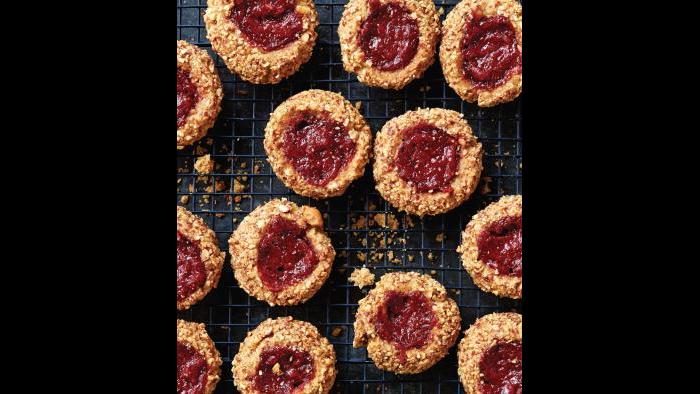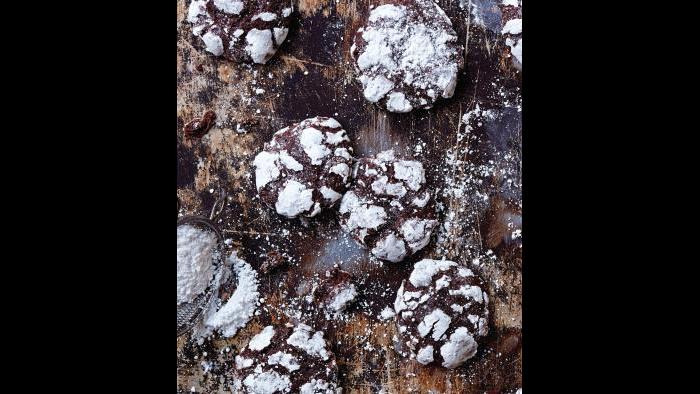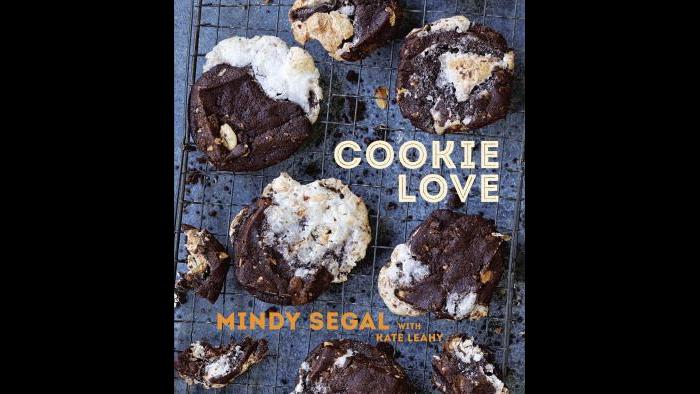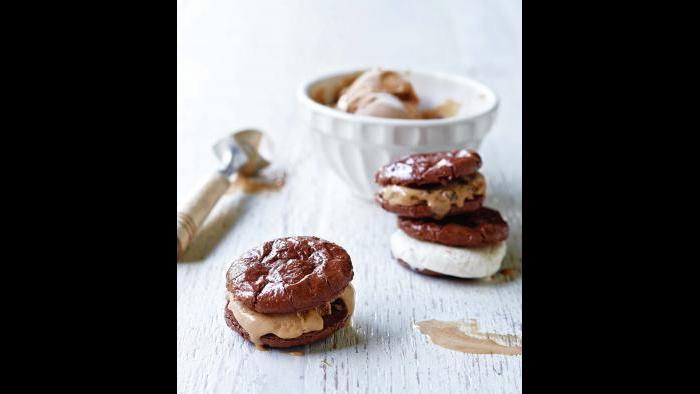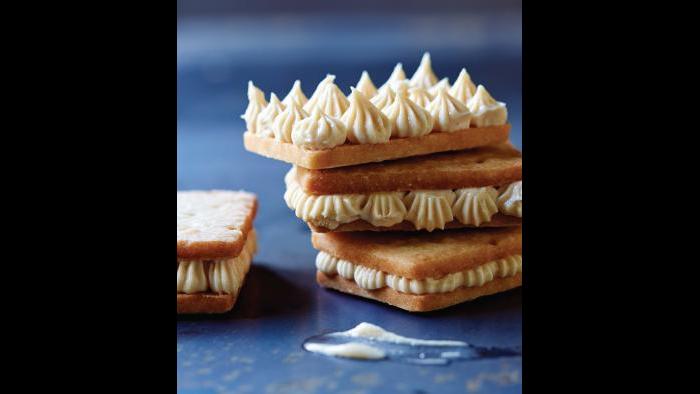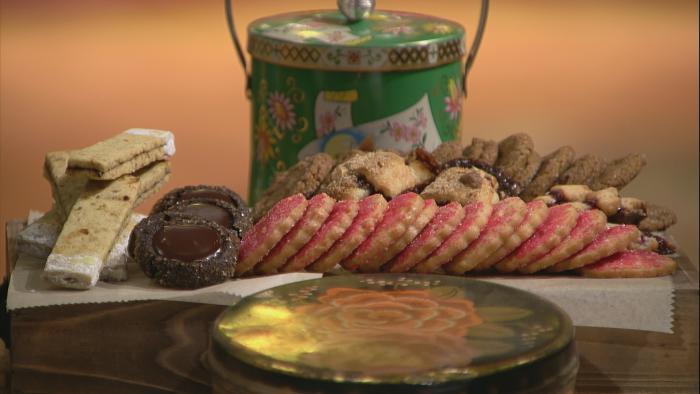Mindy Segal is a James Beard award-winning pastry chef and owner of the restaurant Mindy’s Hot Chocolate in Chicago's Bucktown neighborhood.
Segal joins “Chicago Tonight” to share her favorite holiday recipes from her first cookbook, “Cookie Love,” and to talk about her latest baking business–a line of cannabis-infused desserts that will be sold to medical marijuana patients in Illinois, and possibly nationwide in states where the drug is legal.
Below, highlights from our conversation with Segal and recipes for ginger sorghum cookies, pistachio shortbread with cranberry preserves and hot fudge thumbprints.
 Mindy Segal
Mindy Segal
As a pastry chef, you make a full line of different pastries. Why did you focus on cookies for your first cookbook?
“Well, first of all, most pastry chefs and chefs write body of work books, and I kind of wanted to do something a little different and write a series of cookbooks that were single subject—only because I have a lot to say about each of the categories of pastry. So I started out with cookies because cookies are my favorite and I love them. I’ve been baking cookies since I was 13 and I have sort of my own unique twist and I wanted to teach people my recipes.”
You say that salt is an ingredient in cookies that people don’t use enough of. Can you explain?
“I think that people are afraid to put salt in their baking because they think that it isn’t healthy. But actually what it does, it counteracts and it balances the sugar. And if you don’t have salt in your pastry, especially cookies, they’re too sweet and they’re coying, and that’s like the worst thing in the world. Balance and texture are the most important. So, with that, I use a lot of different salts.”
You said that different cookies suit different moods. What’s the mood for chocolate chips?
“Well, chocolate chip cookies are really for anybody and everything. And that’s a really bad example because everybody loves a chocolate chip cookie.”
How about another example?
“Okay, let’s talk about gingersnaps. When you bite into a gingersnap, it reminds you of the holidays. For me, it reminds me of when I used to eat windmill cookies when I was a little girl. So all different cookies sort of almost take you back to either a memory, or they invent a new memory for you. And it could be that you’re on a date and you’re eating beautiful cookies together, and then it makes you remember this date that you had.”
You’re about to embark on another culinary and professional experiment: selling your own line of marijuana-infused baked goods. Why are you drawn to that?
“This came up a couple of years ago when I knew that llinois was going to pass the law to legalize medical marijuana. And I knew that I had a talent that I could put into this industry. And I started thinking about what I do for a living and what I do for a living is I make people happy—or I try to make people happy, I try to give them a good time, I cook them food, they come to my restaurant, they have a great experience with good service. And so I thought that doing this line of edibles was an extension of exactly what is in my heart and why I do this in the first place, and that’s to make people happy and to make people feel good.”
Where will people be able to buy these?
“First of all, you have to go to one of the dispensaries in Illinois and you have to be able to have a medical marijuana card, and then you have to have a prescription from your doctor. So it’s not like anybody can walk off the street—at this point in time in Illinois—and buy something with cannabis in it.”
Most cooks taste what they are making. Legally, can you taste these?
“I can legally in the facility when I’m licensed to go to Joliet for Cresco Labs. It’s not like I’m going to make them in my house and then go out and go dancing all night. I’m doing this actually for people who are sick.”
Are you concerned about tarnishing your reputation by going this route?
“No. I’ve always been a person that does what I feel is the right thing to do. And I feel this is the right thing to do for my career and for me. And I think that I have a lot to offer the industry and my mom and dad said it’s OK. My husband said it was OK too, and my in-laws.”
When will these cannabis treats be available?
“We’re shooting for February in Illinois. Right now we’re in the process of working out the details and the pricing and the packaging.”
Ginger sorghum cookies (Dan Goldberg © 2015)
makes approximately 31 cookies
¾ cup (6 ounces) unsalted butter, at room temperature
1 ¼ cups firmly packed dark muscovado sugar or dark brown sugar
1 extra-large egg, at room temperature
1 teaspoon pure vanilla extract
¼ cup sorghum
2 ⅓ cups unbleached all-purpose flour
2 teaspoons baking soda
½ teaspoon kosher salt
½ teaspoon sea salt flakes
1 ½ teaspoons grated fresh ginger
2 teaspoons ground ginger
1 teaspoon ground cinnamon
⅛ teaspoon ground clove
⅛ teaspoon ground nutmeg
⅛ teaspoon freshly ground black pepperFOR COATING
½ cup cane sugar
2 teaspoons ground cinnamonTHE WEEKLY NEWSPAPER Chicago Reader runs a series in which local chefs pick an ingredient and challenge another chef to make something with it. In 2011, when it was my turn, I got sorghum, which was a lucky break. (I was dreading mayonnaise or goat cheese.) For the challenge, my friend Rodrick Markus of Rare Tea Cellar set me up with vanilla sorghum syrup aged in a bourbon barrel.
Extracted from sorghum cane, sorghum syrup tastes lighter than molasses, with a more rounded sweetness. I was sold. After I completed the Reader’s challenge (by making a carrot sorghum cake with a cheesecake layer), I added the ingredient to my pantry. I now use it frequently in place of molasses.These cookies are all about the contrast between the mellow sweetness of sorghum, the fresh pop of grated ginger, and the earthy qualities of ground ginger and black pepper. The complexity of the spices allows them to pair well with Belgian-style ales—a fact not lost on Rochefort, a Belgian Trappist brewery that offers ginger cookies with beer tastings.
In the bowl of a stand mixer fitted with the paddle attachment, mix the butter briefly on medium speed for 5 to 10 seconds. Add the muscovado sugar and beat until the butter mixture is aerated and pale in color, approximately 4 minutes. Scrape the sides and bottom of the bowl with a rubber spatula to bring the batter together.
On medium speed, add the egg, vanilla, and sorghum to the butter mixture and mix briefly to combine. Scrape the sides and bottom of the bowl with a rubber spatula to bring the batter together. Mix on medium speed for 20 to 30 seconds to make nearly homogeneous.
In a bowl, whisk together the flour, baking soda, salts, fresh and ground ginger, cinnamon, clove, nutmeg, and pepper.
Add the dry ingredients all at once and mix on low speed until the dough just comes together but still looks shaggy, approximately 30 seconds. Remove the bowl from the stand mixer. With a plastic bench scraper, bring the dough completely together by hand.
Transfer the dough to a sheet of plastic wrap and wrap tightly. Refrigerate overnight.
Reprinted with permission from Cookie Love by Mindy Segal, copyright © 2015. Published by Ten Speed Press, an imprint of Penguin Random House LLC. Photography credit: Dan Goldberg © 2015
PISTACHIO SHORTBREAD WITH CRANBERRY PRESERVES
Pistachio shortbread with cranberry preserves (Dan Goldberg © 2015) makes approximately 68 cookies
CRANBERRY PRESERVES
1 cup fresh or frozen cranberries
½ cup granulated sugar
½ cup freshly squeezed orange juice
Pinch of saltPISTACHIO SHORTBREAD
1 cup (8 ounces) cold, salted butter, cubed (see page 46)
½ cup granulated sugar
1 cup shelled, toasted, salted pistachios
1 ½ cups unbleached all-purpose flour
1 teaspoon kosher salt
8 ounces white chocolate, melted, for garnish (optional)
Red and green sanding sugar, for garnish (optional)THESE ARE SMALL, FESTIVE cookies. I make them around the holidays and give them away as gifts—who doesn’t like toasted pistachios? I like to dip the ends in white chocolate and then green and red sanding sugar to make them stand out on a cookie platter, but this is optional; the cookies are great on their own.
It is easy to buy freshly toasted, shelled, salted pistachios. But if you have untoasted pistachios, toast them in a 325°F oven until lightly tanned, 10 to 15 minutes, before making the shortbread.
To make the cranberry preserves:
In a small pot, bring the cranberries, sugar, orange juice, and salt to a boil over medium-high heat. Lower the heat slightly and cook down until most of the liquid has evaporated and the cranberries are very soft, 10 to 15 minutes. While still hot, puree in a food processor until smooth. Cool to a cool room temperature. As the puree cools, it will thicken. You will have approximately ½ cup.
To make the Pistachio shortbread:
Put the butter and sugar into the bowl of a stand mixer and refrigerate until the butter is firm, approximately 30 minutes.
Meanwhile, put the pistachios in the freezer and freeze until chilled, approximately 20 minutes
In a bowl, whisk together the flour and salt. Put the pistachios in a food processor.
Add the flour mixture and blend until a coarse meal forms and no large pieces of pistachio remain. Do not overblend or the pistachios will form a paste.
Remove the bowl from the refrigerator. Fit the stand mixer with the paddle attachment. Add the flour-nut mixture to the butter and sugar and mix on low speed until the dough starts to resemble a coarse meal, approximately 5 minutes. Increase the speed to medium and mix until the dough just starts to clump around the paddle or to the sides of the bowl, 2 to 3 minutes more. Remove the bowl from the stand mixer. With a plastic bench scraper, bring the dough completely together by hand.
Place the dough on a surface lightly dusted with flour and roll back and forth into a cylinder. Put the dough on a lightly floured piece of parchment paper the same dimensions as a half sheet (13 by 18-inch) pan. Using your fingers, pat the dough into a rectangle. With a rolling pin, roll the dough into an approximately 13 by 18-inch rectangle. If any cracks form in the dough, stop to push them together. To keep the dough from sticking to the parchment paper, dust the top lightly with flour, cover with another piece of parchment paper, and, sandwiching the dough between both sheets of parchment paper, flip the dough and paper over. Peel off the top layer of parchment paper and continue to roll.
Replace the top layer of parchment paper and transfer to a half sheet pan. Refrigerate until firm, at least 1 hour or up to 3 days.
Remove the shortbread from the refrigerator and let it sit at room temperature for 10 minutes.
Spray a quarter sheet (9 by 13-inch) pan or glass baking dish with nonstick cooking spray and line with plastic wrap, leaving 5 inches of overhang on the short sides and 7 inches on the long sides.
Cut the layer of shortbread in half crosswise to create 2 rectangles each. Put one half of the shortbread into the quarter sheet pan. If it falls short of the edges, roll the dough into the corners using a pastry roller. If it is too large, trim the sides.
Using an offset spatula, spread the cranberry preserves evenly over the layer of shortbread. Do not miss the corners. Put the remaining shortbread half on top. Cover with the plastic wrap overhang and smooth the surface with a pastry roller. Refrigerate overnight.
Heat the oven to 325°F. Line a couple of half sheet pans with parchment paper and coat with nonstick cooking spray. Remove the shortbread from the refrigerator and let sit for 20 minutes at room temperature.
Unmold the shortbread. Trim off the sides. Cut the shortbread lengthwise into thirds approximately 2 ½ inches wide. Slice each third crosswise into ½-inch thick strips.
Place 30 strips on a prepared sheet pan with the cut-side facing up. Bake for 10 minutes. Rotate the pan and bake until the shortbread strips are firm to the touch, 8 to 10 minutes more. Repeat with the remaining dough. Cool the shortbread completely on the sheet pans.
To decorate (optional): dip the ends of the cookies into the white chocolate, followed by the sanding sugar. Place on parchment paper and let set.
The cookies can be stored in an airtight container at room temperature for up to 1 week. Dough can be refrigerated for up to 1 week.
Reprinted with permission from Cookie Love by Mindy Segal, copyright © 2015. Published by Ten Speed Press, an imprint of Penguin Random House LLC. Photography credit: Dan Goldberg © 2015
Hot fudge thumbprints (Dan Goldberg © 2015) makes approximately 54 cookies
COOKIES
1 cup (8 ounces) unsalted butter, at room temperature
1 ⅓ cups granulated sugar
1 extra-large egg, at room temperature
1 extra-large egg yolk, at room temperature
2 tablespoons heavy cream
1 teaspoon pure vanilla extract
2 cups unbleached all-purpose flour
1 cup Dutch-processed cocoa powder
1 teaspoon kosher salt
½ teaspoon sea salt flakesFOR SHAPING AND FILLING
1 heaping cup smoked sugar or demerara sugar
1 cup Hot FudgeA MUG OF HOT chocolate in cookie form, this recipe shows how an untraditional component—hot fudge—can change the way we think about thumbprint cookies. The hook is texture: the creamy hot fudge contrasts with the crunchy sugar used to coat the outside of the cookie. (I use smoked sugar, but demerara sugar—see page 268—works, too.) The result is one of my most popular thumbprint cookies to date. If you love chocolate, this might become your favorite recipe in this book.
To make the cookies:
In the bowl of a stand mixer fitted with the paddle attachment, mix the butter briefly on medium speed for 5 to 10 seconds. Add the sugar and beat together until the butter mixture is aerated and pale in color, approximately 4 minutes. Scrape the sides and bottom of the bowl with a rubber spatula to bring the batter together.
Put the egg, yolk, heavy cream, and vanilla into a small cup or bowl.
In a bowl, whisk together the flour, cocoa, and salts.
On medium speed, add the egg and yolk to the butter mixture and mix until the batter resembles cottage cheese, approximately 10 seconds. Scrape the sides and bottom of the bowl with a rubber spatula to bring the batter together. Mix on medium speed for 20 to 30 seconds to make nearly homogeneous.
Add the dry ingredients all at once and mix on low speed. Mix until the dough comes together but still looks shaggy, approximately 30 seconds. Scrape the sides and bottom of the bowl to bring the batter together. Mix for another 10 seconds on medium speed. Remove the bowl from the stand mixer. With a plastic bench scraper, bring the dough completely together by hand.
Transfer the dough to a sheet of plastic wrap and pat into an 8-inch square. Wrap tightly and refrigerate until firm, at least 2 hours or preferably overnight.
Heat the oven to 350°F and line a couple of half sheet (13 by 18-inch) pans with parchment paper.
To shape the cookies:
Cut the dough into 6 even strips. Roll the strips back and forth into logs to round out the edges. Sprinkle the smoked sugar on the work surface and roll the logs in the sugar to coat. Using the top half of your thumb as a guide, cut each log into 9 pieces but keep the log together. Roll the logs again to round out the edges, then pull the pieces apart and place cut-side up on the prepared pans, evenly spacing up to 20 cookies per pan. With the tip of your index finger, make an indentation in the center of each cookie.
Bake one pan at a time for 8 minutes. Remove the pan from the oven and tap down the centers with the rounded end of a wooden spoon or a cocktail muddler. Rotate the pan and bake until the cookies have slight cracks on the top and are set, another 4 to 6 minutes. When ready, the cookies will have set around the edges and you will be able to gently move them. Let the cookies cool completely on the pan. Repeat with the remaining pan.
To fill the cookies:
Heat the hot fudge briefly in a pot over high heat until the sides start to melt. Stir well, then transfer to a squeeze bottle or have a teaspoon ready.
Once the cookies are completely cool, squeeze enough hot fudge onto the cookies to fill the indentation or spoon the hot fudge into the center. Refrigerate the cookies until the hot fudge has set, approximately 30 minutes.
The cookies can be stored in an airtight container at room temperature for up to 3 days or in an airtight container in the refrigerator for up to 1 week. Dough can be refrigerated for up to 1 week.
Reprinted with permission from Cookie Love by Mindy Segal, copyright © 2015. Published by Ten Speed Press, an imprint of Penguin Random House LLC. Photography credit: Dan Goldberg © 2015
 Mindy Segal's "Cookie Love" (Dan Goldberg © 2015)
Mindy Segal's "Cookie Love" (Dan Goldberg © 2015)

